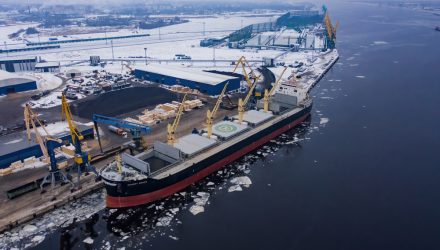ETF Trends CEO Tom Lydon discussed the Breakwave Dry Bulk Shipping ETF (BDRY) on this week’s “ETF of the Week” podcast with Chuck Jaffe on the MoneyLife Show.
BDRY is designed to reflect the daily price movements of the near-dated dry bulk freight futures. The fund offers investors unleveled exposure to dry bulk freight without the need for a futures account. It also provides transparency to investors by listing all its holdings daily. BDRY is designed to reduce the effects of rolling contracts by using a laddered strategy to buy contracts while letting existing positions expire and settle in cash. Finally, the fund is in a commodity pool that issues shares that may be purchased and sold on NYSE Arca.
BDRY is the best performing non-leveraged ETF of 2021. It is +267% year-to-date. With that in mind, what’s happening with dry bulk shipping freight rates?
There has been a rise in dry bulk freight rates, the highest in the last 10 years. Ocean freight rates have risen three-fold in the last six months. The cost of freight from China is up 200%. The world is currently witnessing heightened demand for global shipping for goods, but an ongoing supply-side bottleneck.
Port Protocols
The market is also seeing inefficiencies in the supply chain caused by the COVID-19 protocols at various ports. There is a lot of confusion, and each of the ports – especially in the importing countries in the far east – and this tends to change and have stricter protocols on COVID-19. For example, Some ports in China have restricted the number of people who can board the ship.
To discharge a bulk carrier, one needs quite a few people to come on board. It means one must be going to take two-three days extra to discharge the ship. In one voyage, which is 50-100 days, that is to do 4 percent, which is gone in capacity, which means that the market will get tighter.
Earlier in the year, people thought this was a short-term spike in the market, but now people see it as more structural and longer-term. Demand for cargoes of raw materials like coal and iron ore has jumped this year, outpacing an expansion of the fleet as economies recover from the ravages of the pandemic. Exacerbating tight vessel supply, Covid-related disruptions have cut how many ships are available, tilting the market further in favor of owners.
As long as a strong commodity market backdrop remains, rates are likely to stay firm. For example, the trend will continue during 2021 as coal imports surge while winter approaches in the Northern Hemisphere. For the mid- to long-term – as long as China’s GDP growth rate continues to grow, the demand for raw materials will keep expanding.
Listen to the full podcast episode on BDRY:
For more podcast episodes featuring Tom Lydon, visit our podcasts category.
Read more on ETFtrends.com.
The views and opinions expressed herein are the views and opinions of the author and do not necessarily reflect those of Nasdaq, Inc.
www.nasdaq.com
